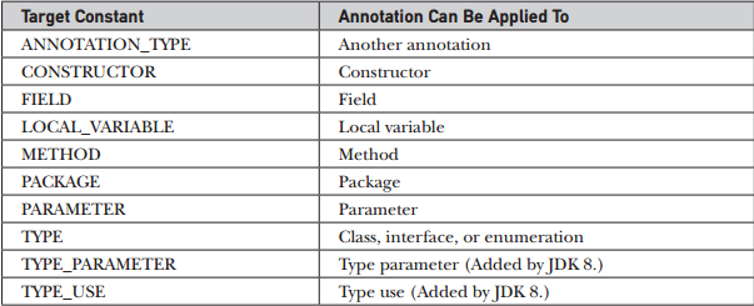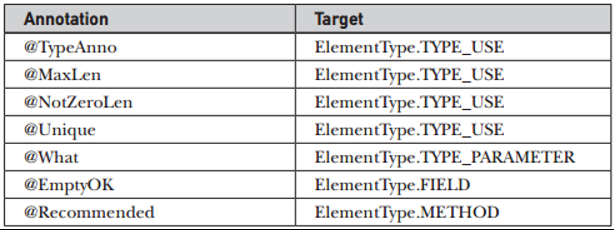- Annotations
- Get Annotations at Run Time by Use of Reflection
- AnnotatedElement Interface
- Built-in Annotations
- Type Annotations – JDK8
- Repeating Annotations
- Annotaions Restrictions
Annotations
- To embed supplemental information into a source file, it does not change the actions of a program.
- An annotation is created through a mechanism based on the interface.
- consist solely of method declarations with no bodies as java provides implementation.
- methods act much like fields.
@interface MyAnno {
String str() default "Testing";
int val() default 100;
}
- An annotation cannot include an extends clause as they automatically extend the Annotation interface.
- package - java.lang.annotation.
- overrides hashCode( ), equals( ), and toString( ) defined by Object.
- annotationType() - returns a Class object that represents the invoking annotation.
- classes, methods, fields, parameters, enum constants and even annotation can be annotated.
- the annotation precedes the rest of the declaration.
@MyAnno(str = "Annotation Example", val = 100)
public static void myMeth() { // …
- When an annotation member is given a value, only its name is used. Thus, annotation members look like fields in this context.
Specifying a Retention Policy
- Retention policy - determines when an annotation is discarded.
- java.lang.annotation.RetentionPolicy enum - SOURCE, CLASS, and RUNTIME.
- SOURCE – annotation is retained only in the source file and is discarded during compilation.
- CLASS – retained till .class during compilation, discarded by JVM during run time.
- RUNTIME - available for JVM runtime also. greatest annotation persistence.
- An annotation on a local variable declaration is not retained in the .class file.
Get Annotations at Run Time by Use of Reflection
- Annotations with RUNTIME retention policy can be queried at run time using reflection.
- Reflection - feature to get info about a class at run time. (java.lang.reflect package)
- Class object – obtain by .getClass( ) of Object.
final Class<?> getClass( )
- getMethod( ), getField( ), and getConstructor( ) return objects of type Method, Field, and Constructor.
Method getMethod(String methName, Class<?> ... paramTypes) // NoSuchMethodException can be thrown
- Class, Method, Field, or Constructor object - getAnnotation( ) obtains a specific annotation associated with that object.
<A extends Annotation> getAnnotation(Class<A> annoType) // null if not found
import java.lang.annotation.*;
import java.lang.reflect.*;
@Retention(RetentionPolicy.RUNTIME)
@interface MyAnno {
String str();
int val();
}
class Meta {
@MyAnno(str = "Annotation Example", val = 100) // Annotate a method.
public static void myMeth() {
Meta ob = new Meta();
try {
Class < ? > c = ob.getClass();
Method m = c.getMethod("myMeth");
// Method m = c.getMethod("myMeth", String.class, int.class);
// myMeth(String str, int i){}
MyAnno anno = m.getAnnotation(MyAnno.class); // get single annotation
System.out.println(anno.str() + " " + anno.val());
Annotation annos[] = ob.getClass().getAnnotations(); // get all annotations
System.out.println("All annotations for myMeth:");
for (Annotation a: annos) {
System.out.println(a);
}
} catch (NoSuchMethodException exc) {
System.out.println("Method Not Found.");
}
}
public static void main(String args[]) {
myMeth();
}
}
// Output
All annotations for myMeth:
@What(description = An annotation test method)
@MyAnno(str = Testing, val = 100)
AnnotatedElement Interface
java.lang.reflect.AnnotatedElement`
getAnnotation()getAnnotations()- Annotation[ ]
getDeclaredAnnotations()- all non-inherited annotations -
isAnnotationPresent(Class<? extends Annotation> annoType) - JDK 8 adds
getDeclaredAnnotation(),getDeclaredAnnotationsByType(), andgetAnnotationsByType(). - Last two automatically work with a repeated annotation.
Marker Annotations
- contains no members, used to mark an item. And check it using
isAnnotationPresent(). - @MyMarker() and @MyMarker both are valid.
- @MyMarker is used without parenthesis due to no members present.
Single-Member Annotations
- Only one member or all other with default values.
- Allows shorthand representation - @MySingle(100)
Built-in Annotations
java.lang.annotation
- used with other annotations only.
- @Retention - used only as an annotation to another annotation to specify retention policy.
- @Documented - marker annotation that tells a tool that an annotation is to be documented.
- @Inherited - marker annotation. Makes the annotation inheritable to a subclass.
- @Target - types of items allowed for annotation and takes one argument, array of constants of the ElementType enumeration.
- If you don’t use @Target, all are allowed except type parameters.

@Target( { ElementType.FIELD, ElementType.LOCAL_VARIABLE } )
java.lang
- @Override - marker annotation for methods. ensure methods are overridden not simply overloaded, compile-time error caused.
- @Deprecated - marker annotation that a declaration is obsolete and has been replaced by a newer form.
- @FunctionalInterface - marker annotation(JDK 8) for interfaces. Indicates an interface with only one abstract method.
- Functional interfaces are used by lambda expressions.
- It is purely informational, not mandatory. It becomes only by definition of exactly one abstract method.
- @SafeVarargs - marker annotation for methods and constructors.
- It indicates that no unsafe actions related to a varargs parameter occur and suppress unchecked warnings.
- It must be applied only to vararg methods or constructors that are static or final.
- @SuppressWarnings
- specifies warnings that might be issued by the compiler are to be suppressed. The warnings to suppress are specified by name, in string form.
Type Annotations – JDK8
- With JDK 8, annotations can be used in new places which were originally allowed only on declarations.
- can annotate return type of method, type of this in a method, a cast, array levels, an inherited class, and a throws clause.
- can also annotate generic types, including generic type parameter bounds and generic type arguments.
- type annotation must include ElementType.TYPE_USE as a target.
- For example, assuming some type annotation called @TypeAnno, the following is legal:
void myMeth() throws @TypeAnno NullPointerException { // ...
- You can also annotate the type of this (called the receiver).
- this is an implicit argument to all instance methods and it refers to the invoking object.
- To annotate its type requires a new JDK 8 feature where you can explicitly declare this as 1st param to a method.
- In this declaration, the type of this must be the type of its class.
int myMeth(@TypeAnno SomeClass this, int i, int j) { // … - It is not necessary to declare this unless you are annotating it.
- If this is not declared, it is still implicitly passed. JDK 8 does not change this fact.
- Also, explicitly declaring this does not change the method’s signature because this is implicitly declared, by default.

- @EmptyOK, @Recommended, @What - not type annotations, included for comparison purposes.
- @What - used to annotate a generic type parameter declaration.
// Demonstrate several type annotations.
import java.lang.annotation.*;
import java.lang.reflect.*;
// Marker Annottions
@Target(ElementType.TYPE_USE)
@interface TypeAnno { }
@Target(ElementType.TYPE_USE)
@interface NotZeroLen {}
@Target(ElementType.TYPE_USE)
@interface Unique { }
@Target(ElementType.TYPE_USE)
@interface MaxLen {int value();}
@Target(ElementType.TYPE_PARAMETER)
@interface What {String description();}
@Target(ElementType.FIELD)
@interface EmptyOK { }
@Target(ElementType.METHOD)
@interface Recommended { }
class TypeAnnoDemo<@What(description = "Generic data type") T> { // type parameter.
public @Unique TypeAnnoDemo() {} // type on a constructor
@TypeAnno String str; // Annotate the type (here, String), not the field.
@EmptyOK String test; // Annotates field.
public int f(@TypeAnno TypeAnnoDemo<T> this, int x) { return 10; } // Annotate this
public @TypeAnno Integer f2(int j, int k) { return j+k;} // Annotate the return type
public @Recommended Integer f3(String str) {return str.length() / 2;} // Annotate method declaration
public void f4() throws @TypeAnno NullPointerException {...} // Type annotation on throws clause
String @MaxLen(10) [] @NotZeroLen [] w; // Annotate array levels
@TypeAnno Integer[] vec; // Annotate array element
public static void myMeth(int i) {
TypeAnnoDemo<@TypeAnno Integer> ob = new TypeAnnoDemo<@TypeAnno Integer>(); //Annotate type argument
@Unique TypeAnnoDemo<Integer> ob2 = new @Unique TypeAnnoDemo<Integer>(); // type annotation with new.
Object x = new Integer(10);
Integer y;
y = (@TypeAnno Integer) x; // type annotation on a cast.
}
public static void main(String args[]) { myMeth(10); }
class SomeClass extends @TypeAnno TypeAnnoDemo<Boolean> {} // type annotation with inheritance clause.
}
Repeating Annotations
- JDK 8 annotation - enables annotation to be repeated on the same element, must be annotated with the @Repeatable.
- value field specifies the container type for the repeatable annotation, an array of the repeatable annotation type.
// Make MyAnno repeatable.
@Retention(RetentionPolicy.RUNTIME)
@Repeatable(MyRepeatedAnnos.class)
@interface MyAnno {String str() default "Testing"; int val() default 9000;}
// This is the container annotation.
@Retention(RetentionPolicy.RUNTIME)
@interface MyRepeatedAnnos { MyAnno[] value(); }
- In getAnnotation(), use the container annotation, not the repeatable annotation.
The output is shown here:
@MyRepeatedAnnos(value=[@MyAnno(str=First annotation, val=-1),
@MyAnno(str=Second annotation, val=100)])
repeated annotations are separated by a comma. They are not returned individually.
- getAnnotationsByType() and getDeclaredAnnotationsByType().
Annotation[] annos = m.getAnnotationsByType(MyAnno.class);
for(Annotation a : annos){ System.out.println(a); }
Annotaions Restrictions
- No annotation can inherit another.
- all methods declared by an annotation must be without parameters.
- they must return one of the following:
- A primitive type, such as int or double
- An object of type String or Class
- An enum type
- Another annotation type
- An array of one of the preceding types
- Annotations cannot be generic, cannot take type parameters.
- annotation methods cannot specify a throws clause.